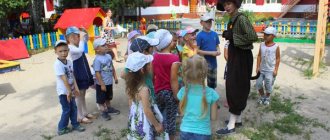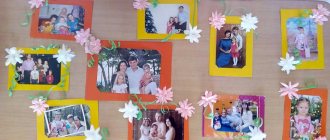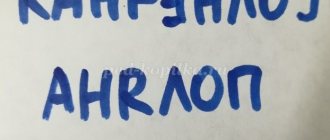MAGAZINE Preschooler.RF
Possibilities of quest games in environmental education of children of senior preschool ageShapirova Anna Valerievna, Educator of MADOU 42, Veliky Novgorod, Novgorod region
Institute of Continuous Pedagogical Education, Novgorod State University named after Yaroslav the Wise
FEATURES OF THE QUEST GAME IN THE ENVIRONMENTAL EDUCATION OF OLDER PRESCHOOL CHILDREN, Shapirova AV
Institute of continuing pedagogical education of Yaroslav-the-Wise Novgorod State University
Abstract: The article describes the problem of choosing various methods, means, forms when organizing the educational process. Goal: to identify the possibilities of quest games in the environmental education of children of senior preschool age. The result is the disclosure of the possibilities of using quest games in the environmental education of children of senior preschool age. The quest game is presented as an effective and relevant means of environmental education for children.
Key words: quest game, environmental quest, environmental education, senior preschool age.
Annotation: The article describes the problem of choosing a variety of methods, tools, and forms in the organization of the educational process. Purpose: to identify the possibilities of the quest game in the environmental education of older preschool children. The result is the disclosure of the possibilities of using the quest game in the environmental education of older preschool children. The quest game is presented as an effective and relevant tool for environmental education of children.
Keywords: quest-game, environmental quest, environmental education, senior preschool age.
The problem of environmental education of children has always been and remains relevant for quite a long time. There are many environmental problems all over the world, so understanding the importance of what is happening, knowing what the consequences of human activity in nature can lead to without understanding the ecological relationships in it, is important from early childhood. When the world is on the verge of an environmental disaster, with the future of all humanity at risk, it becomes obvious that environmental education and training are one of the most pressing problems of our time.
Modern teachers are faced with the task of choosing effective means of environmental education for children. In our opinion, such a means is a quest game, since in a natural and exciting form for a child it allows him to develop the necessary knowledge, skills, and personality traits. This is an innovative form of organizing children’s educational activities in preschool education, which contributes to the development of the child’s active activity position while solving game search problems [1].
In the educational process, a quest is a specially organized type of research activity, where students search for information at specified addresses, including the search for these addresses or other objects, people, tasks. This is a kind of problem that is put before the participants, where they must implement certain tasks.
In our research, the main means of environmental education for children of senior preschool age is a quest game. Let's consider the possibilities of a quest game in solving problems of environmental education of children.
The quest game is of great importance in the environmental education of children of senior preschool age. With the help of a quest game, children gain knowledge about animals, birds and insects, knowledge about the plant world, inanimate nature, and the seasons. With the help of a quest game, children show their attitude to the natural world.
The main goal of the environmental quest is to develop the skills to solve certain problems based on a competent choice of alternative options through the implementation of a certain plot.
In the process of environmental education of children of senior preschool age using quest games, the following targets can be identified:
- Expanding the environmental horizons of older preschoolers;
- Fostering a caring attitude towards the natural world;
- Involving parents in issues of environmental education of older preschoolers;
- Improving the pedagogical skills of educators;
- Creating a creative search in the selection of more effective forms and methods of working with children of senior preschool age.
With the help of a quest game, children are completely immersed in what is happening, receive positive emotions, and are involved in solving assigned problems. Such games not only allow each participant to demonstrate their knowledge, but also contribute to the development of communication interactions between children and their unity. In quests there is an element of competition, when children are divided into teams or subgroups, as well as an element of surprise (an unexpected meeting of the hero) [2].
In the process of theoretical analysis, we identified the following types of environmental quests:
- Research quests. Children need to find information themselves. For example, children at the “rules” must tell the children the rules of behavior in the forest.
- Competitive quests. Quest participants need to complete the task as quickly as possible and move on to the next one. For example, at the Tsvetochnaya Polyana , children are asked to guess riddles against time. They have five minutes to solve the riddles.
- Puzzles. Children need to solve a riddle - a clue in order to complete the next task.
We give an example of an environmental quest game “Take care of nature!” for children of senior preschool age. Analyzing this and other projects, we come to the conclusion that the quest is a game form of organizing educational activities, which makes it exciting, increases the interest of children, and contributes to the formation of sustainable skills for independent acquisition of knowledge.
The quest game brings preschoolers to an awareness of their place and their role in the environment, puts the child in the position of a researcher, a discoverer of connections and patterns existing in nature, contributes to the understanding and solution of environmental problems of their native land, develops a sense of beauty, instills love and respect for nature .
Typically, a quest is an adventure game in which you need to solve problems to advance through the plot. During the control time, participants must complete tasks reflecting examples of solving environmental and biological problems. For preschoolers, a quest game often consists of different types of activities and affects the formation of their competencies in various educational areas, in addition to the set of environmental education.
During the theoretical analysis, we came to the conclusion that the activities, games, and productive activities included in the quest game unite children with common impressions, experiences, emotions, and contribute to the formation of collective relationships. An ecological quest game expands children's understanding of living and inanimate nature, natural phenomena, and the many ecological connections that exist in nature. [4]. In addition to the formation of environmental ideas, the quest will allow you to solve, among other things, the problem of nurturing a caring attitude towards natural objects, teaching you to see them as living creatures that need care and protection. Game techniques make it possible to interest children in this, perhaps not entirely “children’s topic”, difficult to understand. Preschool age is such “fertile soil” that any “good seed” thrown will certainly give rise to good sprouts. The work carried out will help children experience love and affection for their home, family, city, region; feel pride and respect for nature, treat it with care [3].
Thus, the quest game is a new interesting and educational form of environmental education. With the help of the quest game, children gain environmental knowledge, skills and abilities, and also learn to build partnerships; such interaction promotes cohesion between children.
Literature:
- Kostyukova, S.P. Quest as a modern pedagogical technique in senior preschool age / S.P. Kostyukova, N.M. Polyakova: direct // Young scientist. — 2022. — No. 2 (240). — P. 355-358. — URL: https: //moluch. ru/archive/240/55469/ (date of access: 11/11/2020).
- Loseva L.Yu., Kolesnikova I.V. Quest game as a form of educational activity with older preschoolers / L.Yu. Loseva, I.V. Kolesnikova//Collection of materials of the Annual International Scientific and Practical Conference “Education and Education of Young Children -2016. -No. 2. -WITH. 723.
- International educational portal: MAAM. ru // Ecological quest game “Take care of nature” in the older group. [Electronic resource]. – URL: https://www. maam. ru/detskijsad/yekologicheskaja-kvest-igra. html access date (11/19/2020).
- Praleska: preschool education program / E.A. Panko et al. - Minsk: NIO; Aversev, 2007. - 320 s.
| Next > |
Ecological quest “Doing it together”
Ecological quest “Doing it together”
Subject: biology
Class:7
Methods:
story, game
Target:
using game methods to get acquainted with the protected areas of Russia, Chuvashia, Kozlovsky district
Tasks:
- Introduce you to the protected areas of Russia
- Introduce the reserves of Chuvashia and protected areas of the Kozlovsky district
- Organize a station-by-station quest that reveals information about protected living organisms and rules of behavior in nature
Planned results:
subject
- Knowledge of protected areas in Russia, Chuvashia and the Kozlovsky region
- Reproduction of the names of animals and plants listed in the Red Book of Chuvashia;
meta-subject:
- the ability to work with didactic material, with a textbook, with a presentation, with a living object;
- the ability to interact with the station manager and peers in educational and gaming activities;
- the ability to correlate information from different subjects (literature and biology, literature and ecology);
personal:
- develop cognitive interest in protected areas.
Equipment and materials:
computer, multimedia projector
,
music speakers
,
Power Point presentation “Protected Islands”, “Protected Natural Areas of Chuvashia and Kozlovsky District”; Large printed word “RESERVE”; a square with a set of letters; table in 2 columns, the first contains the names of fairy-tale characters - animals; texts describing protected animals and tips for them; verse by Charles Darwin; cutting down a tree, text “Ecological traffic light”
Basic Concepts
: “SPNA”, protected islands, nature reserve, wildlife sanctuary, Red Book.
Educational space
: desks are arranged together, 2 pieces in 3 rows, designed for 15 people. Each row for 1 team. The desks are placed opposite the screen for ease of viewing the presentation. The rest of the classroom space is used to arrange desks so that teams can easily move between them. Each desk is a station where you need to pass a test. High school students are invited to act as station heads and lead the game. Each station has an icon with the name of the station attached. Students can easily navigate using these signs.
Progress of the event:
Organizing time.
High school students talk through a presentation about the Protected Islands of Russia and the protected areas of Chuvashia and the Kozlovsky region. The story contains almost all the biological information that will be useful during the game.
Then each team receives a route sheet and sets off. The route sheet is developed in such a way that teams do not wait for their turn, but can immediately begin completing the task at the assigned station.
There are only 7 stations. At the end of the quest, the guys count the number of points and receive the coveted prize.
Stations:
- “Reserve” - make up as many words as possible with the letters of the word “reserve”,
letters are not repeated (nouns, names, numerals, verbs) for 2.5 minutes.
- “Endangered and Rare”: the team is given a square with a set of letters.
The guys, crossing out all the repeated letters, collect the answer to the question posed from the remaining ones. (2.5 min)
Suggested question:
- Body length 80-90 cm or more, wingspan about 2 m, weight 3-4 kg. The color is dark brown with slight variations. The beak is black, the paws are yellow. Marked on migration (Golden Eagle)
- “I saw you somewhere”
Find out the names of literary and fairy-tale animals, birds, insects (1 point). – if they write the name of the film – 1 point (total 2) – 5 min
Questions
- Gena - “Crocodile Gena”
- Diego the tiger "Ice Age"
- Tartila – Turtle (Water)
- Matroskin - Cat (yogurt)
- Maya———bee – Maya the Bee
- Eeyore the Adventures of Winnipooh
- Baloo———————bear (Chip and Dale to the rescue)
- Nut—mouse (Chip and Dale to the rescue)
- Sid the Sloth, Ice Age
- Nif-nif naf naf, nuf-nuf - three little pigs
- They live with us
Participants receive the text, write down answers on separate pieces of paper, then they are given hints for questions that caused difficulties (an answer without a hint is 4 points, with a hint - 2 points) (5 min)
1. The nest that the animal builds is called gayno. First, he weaves a base from thick branches and twigs, then makes walls, and a roof on top. The animal's home is warm and clean. The housewife lines the inside of her home with moss, lichen, dry blades of grass, leaves and wool. Such a nest usually has one or two entrances, which the hostess plugs with dry lichen in severe frosts.
Clue . In winter this animal is gray, in summer it is red. There are long tufts at the tips of the ears, and the fluffy tail is beautifully curved behind the back.
2. French naturalist Georges Louis Buffon described this animal as follows: “A vile face, a wild appearance, a frightening voice, an unbearable smell, an insidious disposition.”
Clue.
This animal is called the forest orderly.
3. This is an amazing animal. His hearing is more subtle than that of cats and dogs. The animal’s sense of smell is extraordinary—it senses a beetle or larva in the ground at a depth of several meters. But his eyesight is weak. He eats a lot. Usually during the night he eats as much as he weighs. Eats everything: berries, plant seeds, worms, mice, insects and even snakes.
Clue . Although he is small, he is not afraid of predators, he has protection from them.
4. This beast has two main ways of protecting itself from enemies: camouflage and legs. He jumps and runs very easily - so easily that he doesn’t even fall into the snowdrifts. He doesn't just run away from danger, he chooses the shortest path to salvation. But it happens that neither cunning nor speed helps, then he falls on his back and defends himself with his strong hind legs.
Clue . He is considered a big coward.
5. This is the most cunning and cautious animal. He knows how to camouflage perfectly, has acute vision, hearing, and smell. And how he dances! It rises on its hind legs and walks in this position with small checkers. This dance was called "Foxtrot". The animal feeds on insects, rodents, birds, and sometimes animals: hedgehogs, hares.
Clue. Its red fluffy tail helps it escape from its pursuers, with which it covers its tracks.
6. This animal is very agile and dexterous: it can run fast, make big jumps, climb trees and swim. It runs faster uphill than on the plain. He walks through the forest carefully, tries not to make noise, and puts his feet slightly inward.
Clue.
He is considered a clumsy sweet tooth.
Answers
1. Squirrel. 2. Wolf 3. Hedgehog. 4. Hare 5. Fox. 6. Bear.
5) “Food chains”. Read and write all the possible power circuits described in the text, following all the rules for writing it. Keep in mind that the chain usually starts with plants. (5 minutes)
“A ferocious wolf with She-Wolf nursing her cubs is a threat to innocent herds; The eagle, rushing from under the heavens with an arrow, threatens the dove with evil death; The dove, like a sheep, must, while feeding, destroy sprouts and seeds. The owl huntress, in the middle of the dark night, does not feel sorry for the singer of love and languid bliss, And the nightingale eats the firefly, without looking at the beauty of the light. The firefly, the lively light of the night, crawling up, eats the sleepy flower.” E. Darwin
6. Laboratory: Calculate the approximate age of the tree using the growth rings of the wood. (5 minutes)
7. “Ecological traffic light” (5 miles)
The ecological traffic light was installed in order to protect nature and help children observe the rules of reasonable relationships with nature.
- Black color
– stop! Your actions harm the environment.
- Red color
- be careful! Try not to harm nature with your actions! Follow the limits and rules!
- Blue color
– you are a true friend and defender of nature! Your actions are useful for her! Keep helping nature!
Show black, red, blue circles, depending on the decision being made.
- The guys are watching the ants. (With)
- The children left the fire in the forest. (h)
- The guys cut mushrooms with a knife. (To)
- The guys fenced off the anthill. (With)
- Students clear the park of trash. (With)
- The guys saw a nest in the grass. (To)
- Children make a lot of noise in the forest. (h)
- A boy walks with a dog on the lawns. (h)
- The children only walk along the paths in the park. (With)
- Children hang a feeder. (With)
- The guys decided to swim in an unfamiliar place. (To)
- Teenagers wash a motorcycle in the river. (h)
- Children catch tadpoles in the pond. (h)
- Children hang birdhouses in the park. (With)
- Students plant trees near the school. (With)
- The boy carved his initials into the wood with a penknife. (h)
- During a walk, the boy threw an unnecessary piece of paper found in his pocket onto the ground. (h)
- Teenagers throw stones at a stray dog. (h)
- A student brought to school for class a herbarium of rare and endangered plants listed in the Red Book of her region. (h)
- A young correspondent wrote an article for a local newspaper on an environmental topic. (With)
- Children on a walk in the forest killed insects for fun. (h)
- The children arrived at the lake and turned on the music loudly. (To)
- Fishermen use nets and electric fishing rods to catch fish. (h)
- A girl rinses her clothes in the river. (h)
- During the hike, the guys destroyed a bird's nest. (h)




